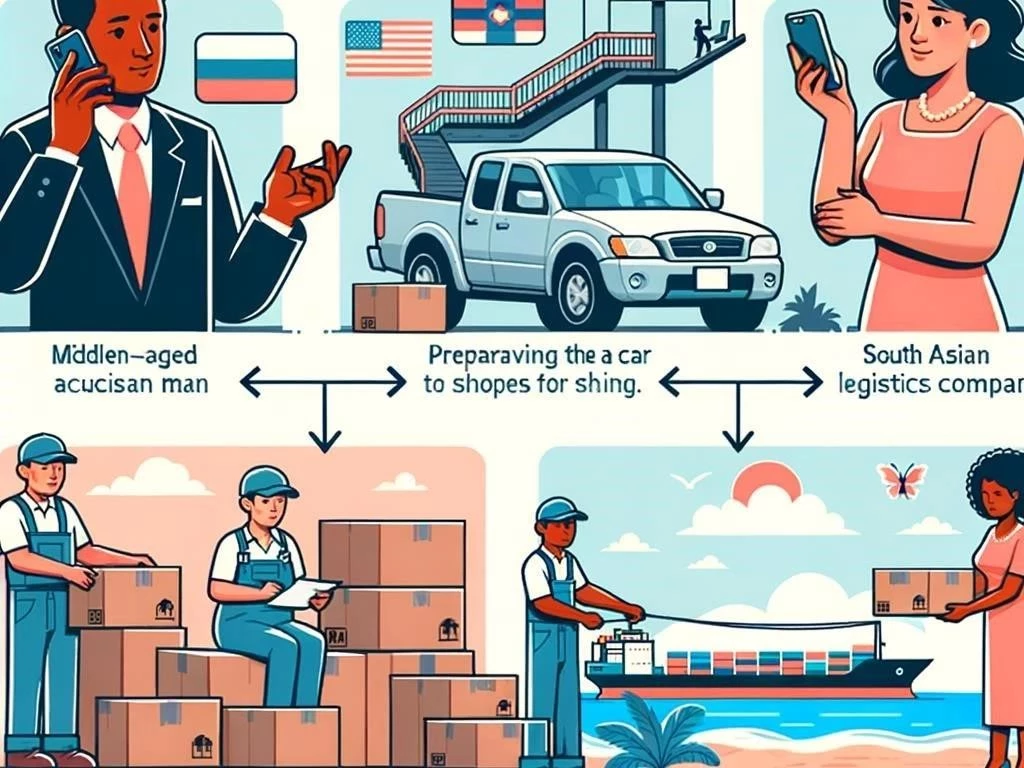How to Ship a Car to Hawaii
Shipping a car to Hawaii involves understanding transport logistics, choosing methods, evaluating providers, and ensuring compliance with customs clearance and state regulations efficiently․
Understanding Car Shipping to Hawaii
When considering car shipping to Hawaii, it’s essential to grasp the logistics involved․ Vehicle relocation requires careful planning, as shipping a car overseas entails different processes compared to domestic transport․ Understanding the available methods, such as container shipping and ro-ro shipping, helps you choose the best option for your needs․ Additionally, it’s crucial to research auto shipping rates, as costs may vary significantly based on factors like the port of departure and destination ports․ Ensure you also factor in potential shipping insurance to protect your vehicle during transit․ Familiarizing yourself with these aspects will streamline the shipping experience and guarantee compliance with local regulations․
Choosing the Right Method of Hawaii Auto Transport
Selecting the appropriate method for Hawaii auto transport is crucial for successful vehicle relocation․ The two primary options are container shipping and ro-ro shipping․ Container shipping offers additional protection, as vehicles are enclosed in containers, safeguarding them from sea elements․ This method is ideal for high-value or classic cars․ Conversely, ro-ro shipping is a more economical choice, where vehicles are driven onto specialized ships and secured on decks․ While it may expose vehicles to weather, it usually has lower shipping costs․ Evaluate your budget, the value of your vehicle, and time frame to determine the best shipping method suited for your needs․
2․1 Container Shipping
Container shipping is a preferred method for transporting vehicles to Hawaii, offering enhanced protection during transit․ This method involves placing your vehicle in a secure container, shielding it from harsh weather conditions and potential damage․ It is ideal for luxury cars, classic vehicles, or those with special features requiring extra care․ The process typically includes selecting a container size, arranging pick-up services, and ensuring proper loading․ While container shipping may come with higher auto shipping rates compared to ro-ro options, the peace of mind it provides is invaluable․ Additionally, confirm that shipping insurance covers your vehicle to mitigate potential risks during transportation․
2․2 Ro-Ro Shipping
Ro-ro shipping, short for “roll-on/roll-off,” is an effective and economical method for transporting vehicles to Hawaii․ This process involves driving your vehicle onto a specialized vessel designed for this purpose, where it is securely parked on the deck․ Ro-ro shipping is advantageous for its simplicity and typically lower shipping costs compared to container options․ However, it exposes vehicles to the elements during transit, which can be a concern for some owners․ It’s essential to prepare your car by removing personal belongings and ensuring it is in good working condition․ Also, verify the availability of shipping insurance to cover any potential damages during transportation․
Comparing Car Transport Companies
When shipping a car to Hawaii, comparing car transport companies is essential for a smooth experience․ Start by gathering quotes from multiple providers, focusing on their auto shipping rates and available services․ Research each company’s reputation through customer reviews and testimonials, ensuring they have experience in Hawaii auto transport․ Evaluate their freight services, including shipping methods, delivery options, and pick-up services, to find a provider that meets your specific needs; Additionally, inquire about shipping insurance policies to protect your vehicle during transit․ By thoroughly comparing these aspects, you can select a reliable company that aligns with your budget and shipping requirements effectively․
3․1 Researching Auto Shipping Rates
Researching auto shipping rates is a crucial step when planning to ship a car to Hawaii․ Begin by requesting quotes from various car transport companies to gain a comprehensive understanding of the prevailing market rates․ Factors influencing these rates include the method of transport, distance, and the type of vehicle being shipped․ Be sure to ask about any additional fees that may apply, such as customs clearance or port handling charges․ Comparing these rates will help you identify competitive options while ensuring that you receive quality service․ Additionally, consider the reputation of the companies, as the cheapest option may not always provide the best experience․
3․2 Evaluating Freight Services
Evaluating freight services is essential when deciding how to ship a car to Hawaii․ Start by assessing the different shipping methods offered, such as container and ro-ro shipping, to determine which best suits your needs․ Look for companies that provide comprehensive information about their services, including shipping timelines, tracking options, and customer support availability․ Additionally, consider their experience with Hawaii auto transport, as familiarity with local regulations can streamline the process․ It’s also important to inquire about handling procedures for fragile or high-value vehicles․ By thoroughly evaluating these factors, you can select a freight service that provides reliability, efficiency, and peace of mind․
Preparing Your Vehicle for Transport
Preparing your vehicle for transport is a critical step when shipping a car to Hawaii․ Start by cleaning your car thoroughly, as this makes it easier to inspect for pre-existing damage․ Remove all personal items, as most transport companies prohibit them during shipping․ Ensure that your vehicle is in good working condition, checking tire pressure, battery, and fluid levels․ Document any existing scratches or dents with photographs, which can be useful for insurance claims if needed․ Lastly, secure a copy of necessary paperwork, including registration and insurance details, to facilitate a smooth shipping process․ Proper preparation ensures a hassle-free vehicle relocation experience․
4․1 Documentation Required for Vehicle Relocation
Documentation is essential for vehicle relocation when shipping a car to Hawaii․ First and foremost, you must provide proof of ownership, such as the vehicle title or registration․ Additionally, a valid driver’s license is required to verify your identity․ It’s also advisable to have a bill of sale if the vehicle is recently purchased․ Depending on the shipping company, you may need to complete a shipping application form detailing the vehicle’s specifications․ Furthermore, ensure that you have any applicable insurance documentation, as this may be necessary for shipping insurance purposes․ Preparing these documents in advance will facilitate a smoother transport experience․
4․2 Shipping Insurance Options
When shipping a car to Hawaii, exploring shipping insurance options is crucial for protecting your investment․ Most car transport companies offer various insurance plans that cover potential damages during transit․ This may include options like basic liability coverage, which is often included in the shipping cost, or comprehensive coverage that protects against theft and extensive damage․ It’s important to understand the terms of each policy, including deductibles and limits․ Additionally, check if your existing auto insurance covers shipping, as some policies may extend to vehicles in transit․ Evaluating these insurance options ensures peace of mind throughout the shipping process․
Understanding Shipping Costs and Time Frame
Understanding shipping costs and time frame is essential when planning to ship a car to Hawaii․ Shipping costs can vary significantly based on factors such as the chosen method, distance, and the type of vehicle․ Container shipping generally incurs higher costs due to added protection, while ro-ro shipping tends to be more budget-friendly․ Additionally, seasonal demand can affect rates, so it’s wise to book early․ The typical shipping time frame ranges from 7 to 14 days, depending on the shipping method and port of departure․ Always confirm with your chosen transport company for the most accurate estimates regarding costs and delivery timelines, ensuring a smooth experience․
5․1 Factors Influencing Shipping Costs
Several factors influence shipping costs when transporting a car to Hawaii․ The primary determinant is the chosen shipping method, with container shipping usually commanding higher fees due to its protective nature․ The size and weight of the vehicle also play a significant role, as larger or heavier cars incur increased costs․ Additionally, the port of departure and destination ports can affect pricing, as some routes may be more expensive than others․ Seasonal demand also impacts rates; prices may rise during peak travel seasons․ Lastly, any additional services, such as expedited shipping or enhanced insurance coverage, can further influence total shipping costs significantly․
5․2 Estimating the Time Frame for Delivery
Estimating the time frame for delivery is crucial when shipping a car to Hawaii․ Generally, the shipping process can take anywhere from 7 to 14 days, depending on various factors․ The chosen shipping method significantly impacts the timeline; for instance, container shipping may take longer due to loading and unloading procedures; Additionally, the port of departure and destination ports influence the delivery schedule, as certain routes may be more direct than others․ Seasonal demand can also affect shipping times; peak periods may result in delays․ Always consult with your transport company for a more accurate estimate based on your specific situation and needs․
Customs Clearance and State Regulations
Understanding customs clearance and state regulations is vital when shipping a car to Hawaii․ Upon arrival, your vehicle must undergo customs inspection, ensuring compliance with federal and state laws․ Necessary documentation, including the vehicle title, registration, and proof of insurance, must be presented to customs officials․ Hawaii has specific regulations regarding emissions and vehicle modifications, which may require additional documentation for compliance․ Additionally, ensure that any outstanding liens or loans on the vehicle are resolved before shipping․ Familiarizing yourself with these requirements helps avoid unnecessary delays and ensures a smoother process for your vehicle relocation to the islands․
6․1 Navigating Customs Procedures
Navigating customs procedures is essential when shipping a car to Hawaii․ Upon arrival, your vehicle will be subject to inspection by customs officials to ensure compliance with import regulations․ First, gather all necessary documents, including the vehicle title, registration, and proof of insurance, to present during this process․ Additionally, be prepared to pay any applicable import duties or taxes, which can vary based on the vehicle’s value․ It’s crucial to understand Hawaii’s specific requirements regarding emissions and safety standards, as non-compliance can lead to delays․ Consulting with your shipping company can help clarify these procedures and facilitate a smoother customs experience․
6․2 Vehicle Registration and Compliance with State Regulations
Vehicle registration and compliance with state regulations are critical steps after shipping a car to Hawaii; Once your vehicle arrives, you must register it with the Hawaii Department of Transportation within 30 days․ This process requires the vehicle title, proof of insurance, and a completed application form․ Additionally, ensure that your vehicle meets Hawaii’s safety and emissions standards, as non-compliance may result in registration denial․ Inspection may be necessary to verify these standards․ Be aware of any local fees associated with registration and ensure all documents are accurate․ Following these steps will facilitate a seamless transition to driving your car in Hawaii․
Finalizing Your Shipping Arrangements
Finalizing your shipping arrangements is a crucial step in the process of transporting your car to Hawaii․ Begin by confirming your chosen shipping method, whether it be container or ro-ro shipping, and verify all details with your selected car transport company․ Ensure you have selected a convenient port of departure and destination ports that align with your schedule․ Review the delivery options available, including door-to-door services or terminal pick-up, to determine what best fits your needs․ Additionally, confirm any required documentation and payment arrangements to avoid last-minute issues․ By meticulously finalizing these details, you can ensure a smooth and efficient shipping experience․
7․1 Selecting a Port of Departure and Destination Ports
Selecting a port of departure and destination ports is essential when shipping a car to Hawaii․ The port of departure is typically chosen based on your location and the shipping company’s service routes․ Major ports, such as Los Angeles or San Francisco, often offer more frequent sailings to Hawaii, potentially reducing shipping times․ When selecting destination ports in Hawaii, consider factors like accessibility and proximity to your final destination․ Popular options include Honolulu, Hilo, and Kahului․ It’s advisable to consult with your transport company for recommendations, as they can provide insights into the most efficient routes and help streamline your shipping process effectively․
7․2 Understanding Delivery Options and Pick-Up Services
Understanding delivery options and pick-up services is crucial when shipping a car to Hawaii․ Car transport companies typically offer various delivery methods, including door-to-door service and terminal delivery․ Door-to-door service provides convenience, as the transport company picks up the vehicle from your location and delivers it directly to your specified address in Hawaii․ Alternatively, terminal delivery requires you to drop off your vehicle at a designated terminal for shipment, with pick-up at the destination port․ Each option has its benefits, such as cost savings or convenience․ Evaluate your specific needs and budget to choose the delivery method that best suits your situation effectively․








